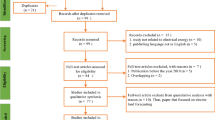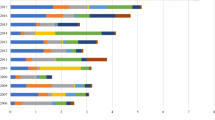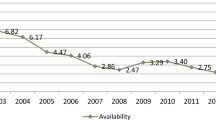Abstract
The literature on incentive-based regulation in the electricity sector indicates that the size of this sector in a country constrains the choice of frontier methods as well as the model specification itself to measure economic efficiency of regulated firms. The aim of this study is to propose a stochastic frontier approach with maximum entropy estimation, which is designed to extract information from limited and noisy data with minimal statements on the data generation process. Stochastic frontier analysis with generalized maximum entropy and data envelopment analysis—the latter one has been widely used by national regulators—are applied to a cross-section data on thirteen European electricity distribution companies. Technical efficiency scores and rankings of the distribution companies generated by both approaches are sensitive to model specification. Nevertheless, the stochastic frontier analysis with generalized maximum entropy results indicate that technical efficiency scores have similar distributional properties and these scores as well as the rankings of the companies are not very sensitive to the prior information. In general, the same electricity distribution companies are found to be in the highest and lowest efficient groups, reflecting weak sensitivity to the prior information considered in the estimation procedure.

Similar content being viewed by others
Notes
Regulation of the electricity distribution sector is changing from an efficiency-oriented instrument to one that also includes the provision of service quality (e.g., Cambini et al. 2014).
A very brief discussion of the radial input distance function and GME estimation, using a sample with eleven companies, were presented at the Conference EEM 2016 (Silva et al. 2016). It was a first preliminary study where efficiency scores were generated but there was neither statistical analysis nor a full interpretation of the efficiency results. The sample used in this study is different and includes two additional companies considered as outliers by ERSE.
Due to these unsolved issues underlying the StoNED model, namely the fact that involves only one output, this method is not used in this study. The models employed in the empirical application involve more than one output.
Price (revenue) caps are established on the basis of the general formula RPI – X, that is the maximum rate of price (revenue) increase is equal to the inflation rate of the retail price index, RPI, minus the expected efficiency savings (X).
Flexible functional forms are either second-order numerical or second-order differential approximations to an arbitrary function and impose considerable fewer restrictions prior to estimation than the traditional technologies, such as Cobb–Douglas, Leontief and CES. The translog form is a second-order numerical approximation of the natural logarithm of an arbitrary function (Chambers 1988).
Besides a small sample size, there is a strong correlation between outputs in this study, as discussed in Sect. 4. The GME estimator is an adequate information-theoretic method to use under these circumstances.
The supports are defined as closed and bounded intervals in which each parameter or error is restricted to lie.
The Serbian EPS and Croatian HEP-ODS are considered outliers by ERSE (ERSE 2011).
In the regulatory period of 2012–2014, ERSE attempts to improve the methodology employed in the distribution activity, with the objective of decreasing OPEX, without harming investment. As a result, the price-cap methodology is applied only to OPEX, where capital costs (CAPEX) are analyzed separately. Excluding CAPEX to set the price-cap, the company is required to propose and accomplish an amount of investment for the regulatory period, avoiding, in this way, the effects of excessive investment. Moreover, this implies remunerating the accepted investment at the company’s cost of capital (ERSE 2011).
VRS is the most relaxed form of returns to scale in the sense that allows not only constant returns to scale but also increasing returns to scale and decreasing returns to scale (Fried et al. 2008, chapter 1).
For details on this procedure, see Fӓre et al. (1994), chapter 3.
Another strategy based on Campbell et al. (2008) was implemented to define the supports in matrix B. Although the efficiency estimates are different, the rankings in terms of efficiency are equal and the elasticities computed at the mean values of inputs and outputs are identical.
Separability between the outputs and the fixed input factor implies that the marginal rate of transformation between the two outputs does not depend on the network length.
For the set of supports [-10,10] and [-4,4], the results are similar.
References
Agrell, J., & Bogetoft, P. (2014). International benchmarking of electricity transmission system operators. In W. Mielczarski & T. Siewierski (Eds.), The 11th international conference on the European energy market, EEM 2014. Los Alamitos, CA: IEEE.
Andor, M., & Hesse, F. (2014). The StoNED age: The departure into a new era of efficiency analysis? A monte carlo comparison of StoNED and the “oldies” (SFA and DEA). Journal of Productivity Analysis, 41, 85–109.
Banovac, E., Glavić, M., & Tešnjak, S. (2009). Establishing an efficient regulatory mechanism—Prerequisite for successful energy activities regulation. Energy, 34(2), 178–189.
Cambini, C., Croce, A., & Fumagalli, E. (2014). Output-based incentive regulation in electricity distribution: Evidence from Italy. Energy Economics, 45, 205–216.
Cambini, C., & Rondi, L. (2010). Incentive regulation and investment: Evidence from European energy utilities. Journal of Regulatory Economics, 38, 1–26.
Campbell, R., Rogers, K., & Rezek, J. (2008). Efficient frontier estimation: A maximum entropy approach. Journal of Productivity Analysis, 30(3), 213–221.
Chambers, R. G. (1988). Applied production analysis: A dual approach. New York: Cambridge University Press. ISBN: 0521314275.
Cossent, R., Gómez, T., & Frías, P. (2009). Towards a future with large penetration of distributed generation: Is the current regulation of electricity distribution ready? Regulatory recommendations under a European perspective. Energy Policy, 37, 1145–1155.
Cullmann, A., & Nieswand, M. (2016). Regulation and investment incentives in electricity distribution: An empirical assessment. Energy Economics, 57, 192–203.
ERSE. (2011). Parâmetros de regulação para o período 2011 a 2014. Lisbon.
Estache, A., Rossi, M. A., & Ruzzier, C. A. (2004). The case for international coordination of electricity regulation: Evidence from the measurement of efficiency in South America. Journal of Regulatory Economics, 25, 271–295.
Färe, R., & Primont, D. (1995). Multi-output production and duality: Theory and applications. Dordrecht: Kluwer Academic Publishers. ISBN: 9789401042840.
Farsi, M., & Filippini, M. (2004). Regulation and measuring cost-efficiency with panel data models: Application to electricity distribution utilities. Review of Industrial Organization, 25, 1–19.
Farsi, M., Filippini, M., & Greene, W. (2006). Application of panel data models in benchmarking analysis of the electricity distribution sector. Annals of Public and Cooperative Economics, 77, 271–290.
Fried, H. O., Lovell, C. A. K., & Schmidt, S. S. (2008). The measurement of productive efficiency and productivity growth. New York: Oxford University Press. ISBN: 9780195183528.
Giannakis, D., Jamasb, T., & Pollitt, M. (2005). Benchmarking and incentive regulation of quality of service: An application to the UK electricity distribution networks. Energy Policy, 33, 2256–2271.
Golan, A. (2018). Foundations of info-metrics: Modeling, inference, and imperfect information. New York: Oxford University Press.
Golan, A., Judge, G., & Miller, D. (1996). Maximum entropy econometrics: Robust estimation with limited data. Chischester: Wiley. ISBN: 9780471953111.
Haney, A. B., & Pollitt, M. G. (2009). Efficiency analysis of energy networks: An international survey of regulators. Energy Policy, 37, 5814–5830.
Haney, A. B., & Pollitt, M. G. (2011). Exploring the determinants of “best practice” benchmarking in electricity network regulation. Energy Policy, 39, 7739–7746.
Haney, A. B., & Pollitt, M. G. (2013). International benchmarking of electricity transmission by regulators: A contrast between theory and practice? Energy Policy, 62, 267–281.
Huang, Y., & Söder, L. (2017). Assessing the impact of incentive regulation on distribution network investment considering distributed generation integration. International Journal of Electric Power and Energy Systems, 89, 126–135.
Jamasb, T., & Pollitt, M. (2001). Benchmarking and regulation: International electricity experience. Utilities Policy, 9, 107–130.
Jamasb, T., & Pollitt, M. (2003). International benchmarking and regulation: An application to European electricity distribution utilities. Energy Policy, 31, 1609–1622.
Kumbhakar, S. C., & Lovell, C. A. K. (2000). Stochastic frontier analysis. Cambridge: Cambridge University Press. ISBN: 0521481848.
Kuosmanen, T. (2006). Stochastic nonparametric envelopment data: combining virtues of SFA and DEA in a unified framework. MTT discussion paper 3/2006.
Kuosmanen, T., & Johnson, A. L. (2010). Data envelopment analysis as nonparametric least squares regression. Operations Research, 58(1), 149–160.
Kuosmanen, T., & Kortelainen, M. (2012). Stochastic non-smooth envelopment of data: Semi-parametric frontier estimation subject to shape constraints. Journal of Productivity Analysis, 38, 11–28.
Lins, M. P. E., Sollero, M. K. V., Calôba, G. M., & Silva, A. C. M. (2007). Integrating the regulatory and utility firm perspectives, when measuring the efficiency of electricity distribution. European Journal of Operational Research, 181, 1413–1424.
Lowry, M. N., & Getachew, L. (2009). Statistical benchmarking in utility regulation: Role, standards and methods. Energy Policy, 37, 1323–1330.
Macedo, P., Silva, E., & Scotto, M. (2014). Technical efficiency with state-contingent production frontiers using maximum entropy estimators. Journal of Productivity Analysis, 41(1), 131–140.
Moutinho, V., Robaina, M., & Macedo, P. (2018). Economic-environmental efficiency of European agriculture—A generalized maximum entropy approach. Agricultural Economics—Czech, 64(10), 423–435.
Pollitt, M. (2005). The role of efficiency estimates in regulatory price reviews: Ofgem’s approach to benchmarking electricity networks. Utilities Policy, 13, 279–288.
Preckel, P. V. (2001). Least squares and entropy: A penalty function perspective. American Journal of Agricultural Economics, 83(2), 366–377.
Rezek, J. P., Campbell, R. C., & Rogers, K. E. (2011). Assessing total factor productivity growth in Sub-Saharan African agriculture. Journal of Agricultural Economics, 62(2), 357–374.
Robaina-Alves, M., Moutinho, V., & Macedo, P. (2015). A new frontier approach to model the eco-efficiency in European countries. Journal of Cleaner Production, 103, 562–573.
Shephard, R. W. (1953). Cost and production functions. Princeton: Princeton University Press.
Shuttleworth, G. (2003). Firm-specific productive efficiency: A response. The Electricity Journal, April, 42–50.
Silva, E., Macedo, P., & Soares, I. (2016). An alternative benchmarking approach for electricity utility regulation using maximum entropy. In J. T. Saraiva & J. N. Fidalgo (Eds.), The 13th international conference on the European energy market, EEM 2016. IEEE: New York, NY.
Tonini, A., & Pede, V. (2011). A generalized maximum entropy stochastic frontier measuring productivity accounting for spatial dependency. Entropy, 13(11), 1916–1927.
Zhou, P., Ang, B. W., & Poh, K. L. (2008). A survey of data envelopment analysis in energy and environmental issues. European Journal of Operational Research, 189, 1–18.
Funding
This work was supported in part by the Portuguese Foundation for Science and Technology (FCT—Fundação para a Ciência e a Tecnologia), through CIDMA—Center for Research and Development in Mathematics and Applications, within project UID/MAT/04106/2013.
Author information
Authors and Affiliations
Corresponding author
Ethics declarations
Conflict of interest
The authors declare that they have no conflict of interest.
Additional information
Publisher's Note
Springer Nature remains neutral with regard to jurisdictional claims in published maps and institutional affiliations.
We would like to express our gratitude to the Editor, Professor Menahem Spiegel, and two anonymous referees. They offered extremely valuable suggestions for improvements.
Appendices
Appendix A
See Table 9.
Appendix B: DEA models
DEA is a non-parametric, mathematical programming-based method to generate the efficient frontier in a given data set and measure the efficiency of each firm relative to the frontier. It fully envelops the data and makes no accommodation for noise (Fried et al. 2008, chapter 1).
The DEA model, assuming CRS, to generate technical efficiency for each firm i, is given as:
where \( {\text{y}}^{\text{i}} \) and \( {\text{x}}^{\text{i}} \) are, respectively, the M-output vector and the N-input vector of firm i, z is a J × 1 intensity vector, where J is the total number of firms in the data set. λ is a scalar whose optimal value is the technical efficiency score of firm i, \( {\text{TE}}({\text{y}}^{\text{i}} ,{\text{x}}^{\text{i}} ) \), which, in turn, is equal to the inverse of the value of the radial distance function.
In the minimization problem, technical efficiency of firm i is assessed in terms of its ability to contract its input vector subject to the efficient frontier. If a radial contraction of the input vector is possible for firm i, its optimal λ < 1 (i.e., firm i is technically inefficient), while if the radial contraction is not possible, its optimal λ = 1 (i.e., firm i is technically efficient).
For model 1, M = 3 and N = 1. For model 2, M = 2 and N = 2, where network length is considered a fixed input. Models 3 and 4 are similar to, respectively, models 1 and 2, except that the former models assume VRS. This assumption is modeled by adding the convexity constraint \( \sum\nolimits_{j} {z^{j} } = 1 \) in the minimization problem, presented above.
Rights and permissions
About this article
Cite this article
Silva, E., Macedo, P. & Soares, I. Maximum entropy: a stochastic frontier approach for electricity distribution regulation. J Regul Econ 55, 237–257 (2019). https://doi.org/10.1007/s11149-019-09383-y
Published:
Issue Date:
DOI: https://doi.org/10.1007/s11149-019-09383-y




